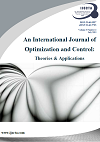Model predictive control-based scheduler for repetitive discrete event systems with capacity constraints
DOI:
https://doi.org/10.11121/ijocta.01.2013.00140Keywords:
Model predictive control, max-plus algebra, capacity constraint, adjustable parameter, internal representationAbstract
A model predictive control-based scheduler for a class of discrete event systems is designed and developed. We focus on repetitive, multiple-input, multiple-output, and directed acyclic graph structured systems on which capacity constraints can be imposed. The target system’s behaviour is described by linear equations in max-plus algebra, referred to as state-space representation. Assuming that the system’s performance can be improved by paying additional cost, we adjust the system parameters and determine control inputs for which the reference output signals can be observed. The main contribution of this research is twofold, 1: For systems with capacity constraints, we derived an output prediction equation as functions of adjustable variables in a recursive form, 2: Regarding the construct for the system’s representation, we improved the structure to accomplish general operations which are essential for adjusting the system parameters. The result of numerical simulation in a later section demonstrates the effectiveness of the developed controller.Downloads
References
Garcia, C.E., Prett, D.M., and Morari, M., Model predictive control: theory and practice – a Survey. Automatica, 25 (3), 335–348 (1989). CrossRef
Wang, L., Model Predictive Control System Design and Implementation Using MATLAB®. Springer, New York (2009).
Cassandras, C.G. and Lafortune, S., Introduction to Discrete Event Systems. Springer, New York (2010).
Hrz, B. and Zhou, M., Modeling and Control of Discrete-event Dynamic Systems: with Petri Nets and Other Tools. Springer, London (2007).
Amari, S., Demongodin, I., Loiseau, J.J., and Martinez, C., Max-plus control design for temporal constraints meeting in timed event graphs. IEEE Transactions on Automatic Control, 57 (2), 462–467, 2011. CrossRef
De Schutter, B., and Van den Boom, T.J.J., Model predictive control for max-plus-linear discrete event systems. Automatica, 37 (7), 1049–1056 (2001). CrossRef
Goto, H., Masuda, S., Takeyasu, K., and Amemiya, T., Derivation algorithm of state-space equation for production systems based on max-plus algebra. Industrial Engineering and Management Systems, 3 (1), 1–11 (2004).
Baccelli, F., Cohen, G., Olsder, G.J., and Quadrat, J.P., Synchronization and Linearity. An Algebra for Discrete Event Systems. Wiley, New York (1992) Available from: http://maxplus.org
Heidergott, B., Olsder, G.J., and Woude, L., Max Plus at Work. Modeling and Analysis of Synchronized Systems. Princeton University Press, New Jersey (2006).
Imaev, A. and Judd, R.P., Block diagram-based modeling of manufacturing systems using max-plus algebra. Proceedings of the American Control Conference, 4711–4716 (2009).
Goverde, R.M.P, A delay propagation algorithm for large-scale railway traffic networks. Transportation Research Part C, 18 (3), 269–287 (2010). CrossRef
Akian, M., Gaubert, S., and Lakhoua, A., Convergence analysis of the max-plus finite element method for solving deterministic optimal control problems. Proceedings of the 47th IEEE Conference on Decision and Control, 927–934 (2008).
Maia, C.A., Andrade, C.R., and Hardouin, L., On the control of max-plus linear system subject to state restriction. Automatica, 47 (5), 988–992 (2011). CrossRef
Amari, S., Demongodin, I., Loiseau J.J., and Martinez, C., Max-plus control design for temporal constraints meeting in timed event graphs. IEEE Transactions on Automatic Control, 57 (2), 462–467(2012). CrossRef
Houssin, L., Lahaye, S., and Boimond, J.L., Control of (max, +)-linear systems minimizing delays, Discrete Event Dynamic Systems, 2012, DOI: 10.1007/s10626-012-0143-1. CrossRef
Declerck, P. and Guezzi, A., Predictive control of timed event graphs with specifications defined by P-time event graphs, Discrete Event Dynamic Systems, 2012, DOI: 10.1007/s10626-012-0150-2. CrossRef
Van den Boom, T.J.J. and De Schutter, B., Model predictive control for perturbed max-plus-linear systems: a stochastic approach. International Journal of Control, 77 (3), 302–309 (2004). CrossRef
Necoara, I., Van den Boom, T.J.J., and De Schutter, B., Hellendoorn, H., Stabilization of max-plus-linear systems using model predictive control: the unconstrained case, Automatica, 44 (4), 971–981, (2008). CrossRef
Goto, H. and Takahashi, H., Efficient representation of the state equation in max-plus linear systems with interval constrained parameters. IEICE Transactions on Fundamentals of Electronics, Communications and Computer Sciences, E95-A (2), 608–612 (2012).
Goto, H., Dual representation and its online scheduling method for event-varying DESs with capacity constraints. International Journal of Control, 81 (4), 651–660 (2008). CrossRef
Goto, H., A lightweight model predictive controller for repetitive discrete event systems, Asian Journal of Control, 2013 (in press)
Nocedal, J. and Wright, S., Numerical Optimization Second Edition. Springer, New York (1999). CrossRef
Hillier, F. S. and Lieberman, G. J., Introduction to Operations Research. McGraw Hill, New York (2004).
Downloads
Published
How to Cite
Issue
Section
License
Articles published in IJOCTA are made freely available online immediately upon publication, without subscription barriers to access. All articles published in this journal are licensed under the Creative Commons Attribution 4.0 International License (click here to read the full-text legal code). This broad license was developed to facilitate open access to, and free use of, original works of all types. Applying this standard license to your work will ensure your right to make your work freely and openly available.
Under the Creative Commons Attribution 4.0 International License, authors retain ownership of the copyright for their article, but authors allow anyone to download, reuse, reprint, modify, distribute, and/or copy articles in IJOCTA, so long as the original authors and source are credited.
The readers are free to:
- Share — copy and redistribute the material in any medium or format
- Adapt — remix, transform, and build upon the material
- for any purpose, even commercially.
- The licensor cannot revoke these freedoms as long as you follow the license terms.
under the following terms:
- Attribution — You must give appropriate credit, provide a link to the license, and indicate if changes were made. You may do so in any reasonable manner, but not in any way that suggests the licensor endorses you or your use.
- No additional restrictions — You may not apply legal terms or technological measures that legally restrict others from doing anything the license permits.
 This work is licensed under a Creative Commons Attribution 4.0 International License.
This work is licensed under a Creative Commons Attribution 4.0 International License.












